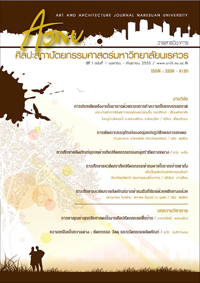การศึกษาและพัฒนาผลิตภัณฑ์จากผ้าทอมือที่พิมพ์ด้วยหมึกยางกล้วย
Main Article Content
Abstract
การวิจัยครั้งนี้มีวัตถุประสงค์เพื่อพัฒนาหมึกพิมพ์สกรีนจากยางกล้วย และนำไปพิมพ์ลายบนผ้าทอมือ เพื่อนำไปออกแบบเป็นผลิตภัณฑ์ประเภทของตกแต่งบ้านในห้องรับแขก ซึ่งในส่วนของหมึกพิมพ์จะใช้สารที่ได้จากธรรมชาติแทนสารสังเคราะห์ โดยใช้ยางกล้วยแทนตัวเรซิน ซึ่งทำหน้าที่เป็นตัวยึดแป้งมันเป็นสารเติมแต่ง และสารให้สีจากธรรมชาติ ในการทดลองครั้งนี้ใช้สารให้สีดังนี้ สีเขียวจากใบหูกวางผสมกับใบมะม่วง สีแดงจากดอกกระเจี๊ยบ สีเหลืองจากผงขมิ้น สีน้ำตาลจากผงกาแฟ โดยผสมตามอัตราส่วน คือ ยางกล้วย 200 มิลลิลิตร แป้งมัน 15 กรัม สารให้สี 100 มิลลิลิตร ต้มในอุณหภูมิ 100 องศาเซลเซียส ทำการทดสอบความเหนียวหนืดของหมึกพิมพ์ และนำไปพิมพ์บนผ้าทอมือ 3 ชนิด คือ ผ้ากัญชง ผ้าฝ้าย ผ้าไหม
ผลการทดลองพบว่า การต้มที่เวลาต่างกัน ทำให้ค่าความเหนียวหนืดที่ได้ต่างกัน และเมื่อทำการพิมพ์บนผ้าพบว่า ค่าความเหนียวหนืดที่ใช้เวลาต้ม 10 นาที ได้ค่าที่ 11,180 เซนติพอยด์ ทำการพิมพ์แล้วให้รายละเอียดของภาพครบถ้วนมากที่สุด และนำไปทดสอบการพิมพ์กับผ้าทอมือ 3 ชนิด พบว่า ผ้าฝ้ายมีค่าความเข้มสูงมากที่สุด และรองลงมาได้แก่ผ้ากัญชง และผ้าไหมน้อยที่สุด และเมื่อนำไปซัก พบว่า ผ้าไหมมีการหลุดลอกของสีออกหมด และผ้าฝ้ายมีการยึดติดดีที่สุด รองลงมาคือผ้ากัญชง
ในด้านการออกแบบผลิตภัณฑ์ส่วนลวดลายเป็นรูปแบบที่แสดงออกถึงภาพลักษณ์ของเอเชีย ด้วยลวดลายดอกซากุระ และต้นไผ่เป็นลายพิมพ์ในของตกแต่งบ้าน 5 ชนิด ได้แก่ ปลอกหมอนอิง โคมไฟ เบาะที่นั่ง ฉากกั้นห้อง และผ้าปูโต๊ะ
A Study and development Handicraft textile Product by Printing with Banana’s Gum
The purpose of this thesis is to develop the screen ink from banana gum which can be printed on homespun cloths. Then the cloths can be used as interior decoration in living rooms. This kind of ink is produced by natural agent instead of synthetic, banana gum which acts as an adhesive agent like resin, tapioca flour as additive agent and colorants from nature. The colorants used in this experiment included green colorant from the mixture of Indian almond and mango leaf, red colorant from rosella, yellow from curcuma powder and brown from coffee powder. Boil the proportions of the ink; 200 milliliters of banana gum, 15 grams of cassava and 100 milliliters of colorant at 100 degree Celsius. After boiling, test for viscosity of the ink and screen on 3 kinds of homespun cloths; hemp-fibril cloths, cotton and silk.
The result of the experiment found that the different boiling time provided different value of viscosity. The 10-minutes boiling outcome ink with the value of viscosity at 11,180 centipoint can provide the most completion of the details. It was found that among three types of the homespun cloths-cotton hemp-fibril cloths and silk-Cotton presented clearest and densest color, followed by hemp-fibril cloths and than silk respectively. About the mattes at discoloration, cotton was the mattesial which most allowed printed ink to adhesive with, follow by hemp-fibril cloths, and silk was worse.

